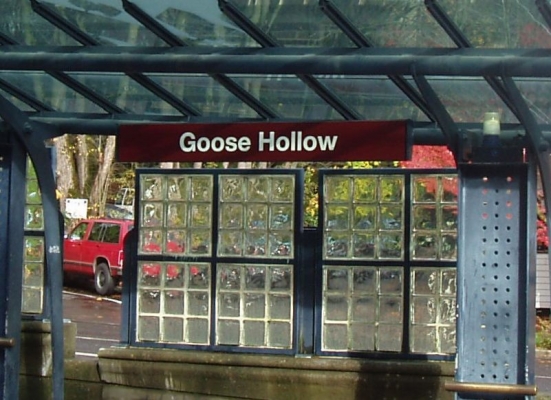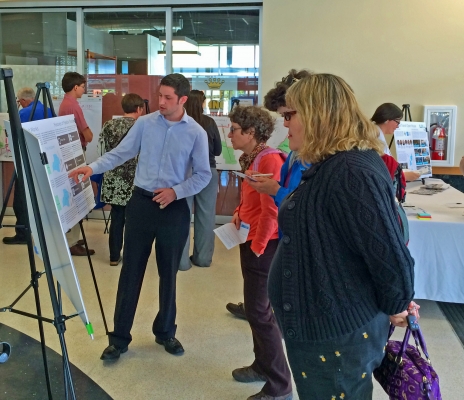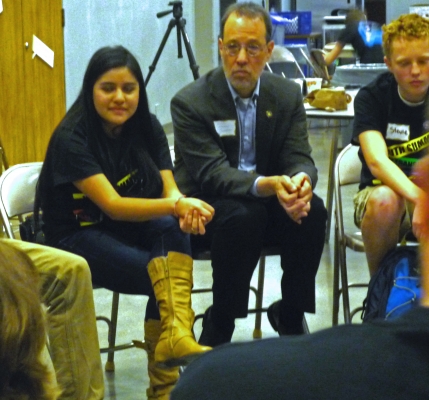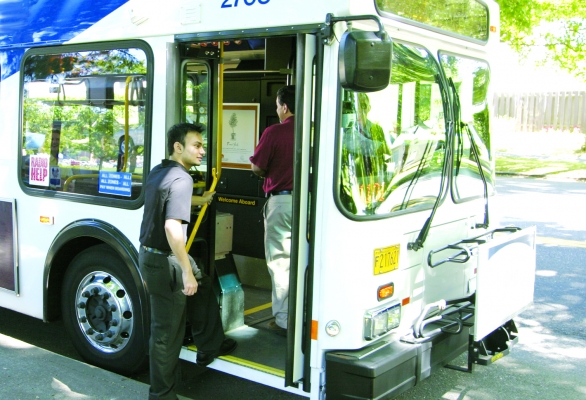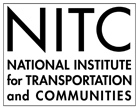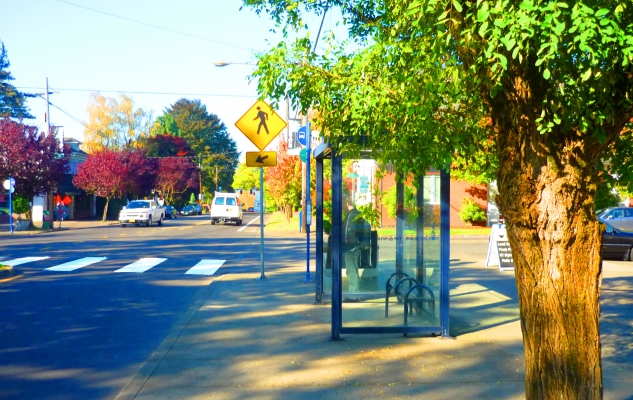A group led by Krista Hager worked on a concept design for bicycle parking at the Goose Hollow eastbound MAX Station in southwest Portland, Ore.
Portland State University students in the Master of Urban and Regional Planning (MURP) program came up with some innovative transit solutions for the Salem-Keizer area, just south of Portland, Ore. in the Willamette Valley.
The Salem-Keizer transit provider, known as Cherriots, requested that a planning group come up with alternative forms of transit that would be a better fit for the study area. MURP students Darwin Moosavi, Brenda Martin, CJ Doxsee, Mike Sellinger, Lauren Wirtis and Matt Berggren took on the challenge as their capstone project.
The bus service currently provided by Salem-Keizer Transit is inefficient in the low-density neighborhoods of West Salem, South Salem, and Keizer. Buses in those neighborhoods often run half-full, or nearly empty, along looping, circuitous roads that lack an interconnected grid pattern.
The student team, Paradigm Planning, proposed a “flexible transit” system which can better serve this type of low-density suburban area.
Fixed-route transit is typical bus service, in which buses come to predefined stops at regularly scheduled intervals. Demand-responsive or paratransit, the opposite extreme, is an on-demand service typically reserved for the elderly or disabled, in which a rider calls to be picked up by a bus at home....
Historically, large-scale transportation infrastructure projects have had devastating outcomes in communities of color. With twentieth-century urban renewal efforts often came the displacement of underprivileged communities, the loss of low-income neighborhoods and their replacement with affluent housing and freeways.
According to new OTREC research from the University of Oregon, transit-oriented development, or TOD, can offer a different trajectory. Rather than displacing residents, TOD has the potential to improve neighborhoods for the benefit of those who live there.
OTREC researcher Gerardo Sandoval grew up near MacArthur park, one of the two sites studied, and has witnessed firsthand the neighborhood’s dramatic change. “I think the coolest thing about MacArthur Park is that now it’s considered a national model for TOD. When I was growing up there … nobody saw it like that. It was thought of more as a low-income area,” Sandoval said.
The project examined two California neighborhoods: MacArthur Park, in Los Angeles, and Fruitvale, in Oakland. In both neighborhoods, the majority of residents are recent immigrants from Mexico and Central America, many of whom have significantly lower incomes and rely heavily on public transportation.
In the last few decades, both sites have seen TOD coincide with neighborhood...
Read moreNote: In advance of the Transportation Research Board's annual meeting, the biggest forum on the transportation research calendar, OTREC.us is profiling some of the researchers who will present their work.
In transit-oriented development, planners typically focus on the neighborhood within a quarter of a mile of a transit stop.
Housing and commercial developments within this "walkable zone" are thought to be the ones primarily affected by, or dependent on, the transit stop.
New research from the University of Utah expands the traditional one-quarter-mile distance away from transit stops to a broader radius of about one and one-quarter mile from a stop.
The project's principal investigator, Susan Petheram, led a team of researchers who used the Salt Lake County assessor's database to analyze property values surrounding light rail stops. Petheram is a NITC doctoral dissertation fellow and the research stems from her dissertation.
"We were seeing a certain negative impact [on property values] right around the core station area for single family homes," Petheram said. Slightly...
Read moreThe NITC program's executive committee has selected a new roster of projects for funding under the National Institute for Transportation and Communities, or NITC, program. The committee chose 10 projects, totaling $900,000, under the NITC theme of safe, healthy and sustainable transportation to foster livable communities.
The projects are national in scope and reflect priority areas including transit supply and outcomes, and pedestrian and bicyclist behavior.
Projects selected include:
- A bicycle and pedestrian miles traveled project for Washington state.
- A study that measures the effectiveness on social media on advancing public transit.
- A look into crowdsourcing the collection of data on transportation behavior.
- A national study of Bus Rapid Transit outcomes.
A complete list of projects and principal investigators is below:
- National Study of BRT Development Outcomes: Arthur Nelson and Joanna Ganning, University of Utah
- Crowdsourcing the Collection of Transportation...
Nohad Toulan’s influence on Portland State University and the wider community can be seen not only in the school bearing his name, the Nohad A. Toulan School of Urban Studies and Planning, but also in the holistic approach to transportation research and education that would help cement Portland’s innovative reputation and shape its transportation center, OTREC.
Toulan, emertitus dean of the College of Urban and Public Affairs, and his wife, Dirce, both died Monday. He was 81 and she was 78.
Toulan helped pave the way for the creation of OTREC by stressing the value of human development, said Robert Bertini, OTREC’s founding director. “Our focus on emphasizing people, on building and encouraging the development of faculty, students and collaborators outside the university, that was directly influenced by the atmosphere created by Dean Toulan,” Bertini said.
Portland State’s Urban Plaza embodies Toulan’s vision of an urban university connected with its city. There, the college’s lessons spill out into a vibrant plaza interwoven with transit and the life of Portland.
OTREC’s—and Portland State’s—reputation for multidisciplinary, collaborative transportation research grew thanks in part to Toulan’s efforts. Toulan extended Bertini, an engineering professor, a joint appointment the College of Urban and Public Affairs. “He said, ‘I need an engineer in my college,’” Bertini...
The U.S. Department of Housing and Urban Development has identified some “livability principles” which include healthy, safe and walkable neighborhoods and safe, reliable and economical transportation choices.
Transit agencies and local governments routinely use metrics to evaluate the performance of transit systems, but a uniform standard of transit data collection does not exist outside of the reporting requirements of the National Transit Database (NTD). Because of the types of data collected for the NTD, the focus of performance measurements is often on ridership and financial performance, leaving aside the question of livability.
In a new project sponsored by OTREC, Principal Investigator Marc Schlossberg, associate professor in the department of planning, public policy and management at the University of Oregon, along with co-investigators Jennifer Dill of Portland State University and Nico Larco, also of the University of Oregon, set out to create a set of tested and refined performance indicators that transit agencies across the nation can use to evaluate and improve their system performance in relation to livability goals.
Traditionally, transit systems are thought of exclusively in their wholeness: how the system serves a region,...
Read more
